Posted :
This
article will show how to install
nginx ,
how to enable
ssl
and http2 for nginx ,
and for the web frameworks for which nginx
serves as a reverse proxy .
It will use the IPFW
firewall
to block all incoming traffic beside
http , https , and
ssh .
It will install
php ,
mariadb
,
Wordpress ,
and it will also install
Postgresql
,
mongodb
and
adminer
. It will
also install nodejs and a wiki web application
for nodejs , and it will install java and the
tomcat server for which it will serve
two web applications .
Before
starting the installation of these
software , we will install the nano editor
to edit configuration files .
[root]$ pkg install nano # install nano on FreeBsd

Configure
the
IPFW
firewall to disable all incoming traffic to the server besides :
http , https and ssh .
[root]$ sysrc firewall_enable="YES" # Make ipfw firewall starts , when # freebsd starts . [root]$ sysrc firewall_quiet="YES" # Be quite executing commands . [root]$ sysrc firewall_type="workstation" # protect the machine using stateful rules . [root]$ sysrc firewall_myservices="22/tcp 80/tcp 443/tcp" # allow ssh http and https only [root]$ sysrc firewall_allowservices="any" # any ip can access the allowed services. [root]$ sysrc firewall_logdeny="YES" # Log only the denied requests. [root]$ service ipfw start # Load the firewall rules
To install nginx , you can use :
[root]$ pkg install nginx-full # install nginx freebsd
Nginx default www directory is
located under /usr/local/www/nginx/ ,
the error logs can be found
under /var/log/nginx/error.log ,
the access logs can be found
under /var/log/nginx/access.log ,
the pid is found under /var/run/nginx.pid and
the configuration file is found
under /usr/local/etc/nginx/nginx.conf .
Make
a backup of nginx.conf :
[root]$ cd /usr/local/etc/nginx [root:/usr/local/etc/nginx/]$ mv nginx.conf nginx.conf.bk
Create
a new nginx.conf file :
[root:/usr/local/etc/nginx/]$ nano nginx.conf
# paste the following content .
worker_processes auto;
events {
worker_connections 1024;
}
http {
server_tokens off;
sendfile on;
tcp_nopush on;
tcp_nodelay on;
include mime.types;
default_type application/octet-stream;
gzip on;
gzip_proxied any;
gzip_vary on;
gzip_http_version 1.1;
gzip_comp_level 6;
gzip_min_length 96;
gzip_types text/plain;
gzip_types text/css;
gzip_types text/xml;
gzip_types application/javascript;
gzip_types application/json;
gzip_types font/woff;
gzip_types font/woff2;
gzip_types font/opentype;
gzip_types image/svg+xml;
gzip_types image/x-icon;
ssl_protocols TLSv1 TLSv1.1 TLSv1.2; # Dropping SSLv3, ref: POODLE
ssl_prefer_server_ciphers on;
ssl_session_cache shared:nginx_SSL:1m;
ssl_session_timeout 1440m;
ssl_ciphers "ECDHE-ECDSA-CHACHA20-POLY1305:ECDHE-RSA-CHACHA20-POLY1305:ECDHE-ECDSA-AES128-GCM-SHA256:ECDHE-RSA-AES128-GCM-SHA256:ECDHE-ECDSA-AES256-GCM-SHA384:ECDHE-RSA-AES256-GCM-SHA384:DHE-RSA-AES128-GCM-SHA256:DHE-RSA-AES256-GCM-SHA384:ECDHE-ECDSA-AES128-SHA256:ECDHE-RSA-AES128-SHA256:ECDHE-ECDSA-AES128-SHA:ECDHE-RSA-AES256-SHA384:ECDHE-RSA-AES128-SHA:ECDHE-ECDSA-AES256-SHA384:ECDHE-ECDSA-AES256-SHA:ECDHE-RSA-AES256-SHA:DHE-RSA-AES128-SHA256:DHE-RSA-AES128-SHA:DHE-RSA-AES256-SHA256:DHE-RSA-AES256-SHA:ECDHE-ECDSA-DES-CBC3-SHA:ECDHE-RSA-DES-CBC3-SHA:EDH-RSA-DES-CBC3-SHA:AES128-GCM-SHA256:AES256-GCM-SHA384:AES128-SHA256:AES256-SHA256:AES128-SHA:AES256-SHA:DES-CBC3-SHA:!DSS";
map $sent_http_content_type $expires {
default off;
application/atom+xml max;
application/javascript max;
application/rss+xml max;
application/vnd.ms-fontobject max;
audio/ogg max;
font/woff max;
font/woff2 max;
font/opentype max;
image/gif max;
image/jpeg max;
image/png max;
image/svg+xml max;
image/x-icon max;
text/css max;
text/html epoch;
video/mp4 max;
}
include servers.conf.d/*.conf;
}
Now create a directory in /usr/local/etc/nginx/ ,
named servers.conf.d :
[root:/usr/local/etc/nginx/]$ mkdir servers.conf.d
and create a configuration file for you website :
[root:/usr/local/etc/nginx/servers.conf.d/]$ nano dev-freebsd.difyel.com.conf
# create a configuration file ,
# name it as you like , the important
# is that it ends with .conf
# paste the following content
server {
listen 80;
listen [::]:80;
server_name dev-freebsd.difyel.com;
root /usr/local/www/nginx/;
client_max_body_size 512M;
# blog
location /blog {
expires $expires;
index index.php index.html index.htm;
try_files $uri $uri/ /blog/index.php?$args;
}
location ~* ^/blog/.*.php$ {
include fastcgi_params;
fastcgi_pass unix:/var/run/php-74-fpm.sock;
fastcgi_param SCRIPT_FILENAME $document_root$fastcgi_script_name;
}
# blog
}
Test the configurations for any errors using :
[root]$ nginx -t # output nginx: the configuration file /usr/local/etc/nginx/nginx.conf syntax is ok nginx: configuration file /usr/local/etc/nginx/nginx.conf test is successful
Make nginx starts when freebsd starts :
[root]$ sysrc nginx_enable="YES"
Start nginx using :
[root]$ service nginx start
You can check if nginx is running , stop it , restart it , and reload its configuration using :
[root]$ service nginx status # Check ig nginx is running . nginx is running as pid 7218. [root]$ service nginx stop # Stop nginx . Stopping nginx. Waiting for PIDS: 7218. [root]$ service nginx start # Start nginx . Performing sanity check on nginx configuration: nginx: the configuration file /usr/local/etc/nginx/nginx.conf syntax is ok nginx: configuration file /usr/local/etc/nginx/nginx.conf test is successful Starting nginx. [root]$ service nginx restart # restart nginx . Performing sanity check on nginx configuration: nginx: the configuration file /usr/local/etc/nginx/nginx.conf syntax is ok nginx: configuration file /usr/local/etc/nginx/nginx.conf test is successful Stopping nginx. Waiting for PIDS: 7280. Performing sanity check on nginx configuration: nginx: the configuration file /usr/local/etc/nginx/nginx.conf syntax is ok nginx: configuration file /usr/local/etc/nginx/nginx.conf test is successful Starting nginx. [root]$ service nginx reload # reload nginx configuration root@freebsd:/usr/local/etc/nginx/servers.conf.d # service nginx reload Performing sanity check on nginx configuration: nginx: the configuration file /usr/local/etc/nginx/nginx.conf syntax is ok nginx: configuration file /usr/local/etc/nginx/nginx.conf test is successful
If you are running you website locally , make your server name resolve locally
by adding the following line to /etc/hosts :
[root]$ echo '127.0.0.1 dev-freebsd.difyel.com' >> /etc/hosts # Replace dev-freebsd.difyel.com with your servername
To
install php on freebsd , use :
[root]$ pkg install php74 # Install php version 7.4 # you can install other versions # for example php73 php72 ... [root]$ pkg search "^php74.*" | less # Search for extensions to use with php # replace 74 with your installed php version # for example , 73 72 . [root]$ pkg install php74-bcmath php74-bz2 php74-curl php74-dom php74-exif php74-fileinfo php74-filter php74-gd php74-gettext php74-intl php74-json php74-mbstring php74-session php74-soap php74-pecl-mcrypt php74-openssl php74-xmlrpc php74-zip php74-zlib php74-pdo_mysql php74-pdo_pgsql php74-pdo_sqlite php74-pdo_firebird php74-sqlite3 php74-pgsql php74-mysqli php74-pecl-mongodb-1.7.4 # install extensions to be used with # php .
Php configuration files are located under /usr/local/etc/php.ini
and /usr/local/etc/php/ . php-fpm configuration files
are located under /usr/local/etc/php-fpm.conf
and /usr/local/etc/php-fpm.d/ . php-fpm pid is
located under /var/run/php-fpm.pid.
To
configure php on freebsd , first create a php.ini link :
# For production , create this link . [root]$ ln -s /usr/local/etc/php.ini-production /usr/local/etc/php.ini # For development , create this link [root]$ ln -s /usr/local/etc/php.ini-development /usr/local/etc/php.ini
Next edit /usr/local/etc/php-fpm.d/www.conf :
[root]$ nano /usr/local/etc/php-fpm.d/www.conf
# Open www.conf for editing .
# search using ctrl-w for
listen = 127.0.0.1:9000
# and replace it with :
listen = /var/run/php-74-fpm.sock
# If you have installed another version
# of php , replace 74 with your version
# for example 73 or 72 ...
# Uncomment the following three
# lines by removing the semicolon.
listen.owner = www
listen.group = www
listen.mode = 0660
Create a secure-php.ini file :
[root]$ nano /usr/local/etc/php/secure-phi.ini max_execution_time = 30 max_input_time = 30 cgi.force_redirect = 1 expose_php = Off display_errors = Off display_startup_errors = Off log_errors = On allow_url_fopen = Off allow_url_include = Off disable_functions = exec,passthru,shell_exec,system,proc_open,popen,curl_exec,curl_multi_exec,parse_ini_file,show_source session.use_strict_mode = 1 session.cookie_secure = 1
Make the php-fpm service starts when FreeBSD boots ,
by issuing the following command :
[root]$ sysrc php_fpm_enable="YES"
Start the php-fpm service using :
[root]$ service php-fpm start
You can use service stop php-fpm to stop php-fpm .
Test
if php is working correctly , create a blog directory under :
/usr/local/www/
[root:/usr/local/www/]$ mkdir blog # create a blog directory under /usr/local/www/
and create a test.php file under /usr/local/www/nginx/blog/ :
[root:/usr/local/www/nginx/blog/]$ echo '<?php phpinfo();?>' > test.php
Visit http://yourdomain.com/blog/test.php ,
and you should have the following page .

Remove the test.php file
[root:/usr/local/www/nginx/blog/]$ rm test.php
Install certbot :
[root$] pkg install py37-certbot # Install certbot under freebsd # you can search for the certbot package # using pkg search certbot .
If
you are running your server locally ,
you must manually create and add
ssl
certificate using certbot .
[root]$ certbot certonly --manual --preferred-challenges dns -d dev-freebsd.difyel.com # replace dev-freebsd.difyel.com with your server name . Saving debug log to /var/log/letsencrypt/letsencrypt.log Plugins selected: Authenticator manual, Installer None Enter email address (used for urgent renewal and security notices) (Enter 'c' to cancel): uremail@address.com - - - - - - - - - - - - - - - - - - - - - - - - - - - - - - - - - - - - - - - - Please read the Terms of Service at https://letsencrypt.org/documents/LE-SA-v1.2-November-15-2017.pdf. You must agree in order to register with the ACME server at https://acme-v02.api.letsencrypt.org/directory - - - - - - - - - - - - - - - - - - - - - - - - - - - - - - - - - - - - - - - - (A)gree/(C)ancel: A - - - - - - - - - - - - - - - - - - - - - - - - - - - - - - - - - - - - - - - - Would you be willing, once your first certificate is successfully issued, to share your email address with the Electronic Frontier Foundation, a founding partner of the Let's Encrypt project and the non-profit organization that develops Certbot? We'd like to send you email about our work encrypting the web, EFF news, campaigns, and ways to support digital freedom. - - - - - - - - - - - - - - - - - - - - - - - - - - - - - - - - - - - - - - - - (Y)es/(N)o: y Obtaining a new certificate Performing the following challenges: dns-01 challenge for dev-freebsd.difyel.com - - - - - - - - - - - - - - - - - - - - - - - - - - - - - - - - - - - - - - - - NOTE: The IP of this machine will be publicly logged as having requested this certificate. If you're running certbot in manual mode on a machine that is not your server, please ensure you're okay with that. Are you OK with your IP being logged? - - - - - - - - - - - - - - - - - - - - - - - - - - - - - - - - - - - - - - - - (Y)es/(N)o: y - - - - - - - - - - - - - - - - - - - - - - - - - - - - - - - - - - - - - - - - Please deploy a DNS TXT record under the name _acme-challenge.dev-freebsd.difyel.com with the following value: qf67JA2BjjUdUsJEqjXCmTsKWHZ_KR4HZRTiNTBU33o Before continuing, verify the record is deployed. - - - - - - - - - - - - - - - - - - - - - - - - - - - - - - - - - - - - - - - - Press Enter to Continue
If you are using namecheap you can add the text record to your domain , by going to Domain list , then select manage under your domain , and advanced .
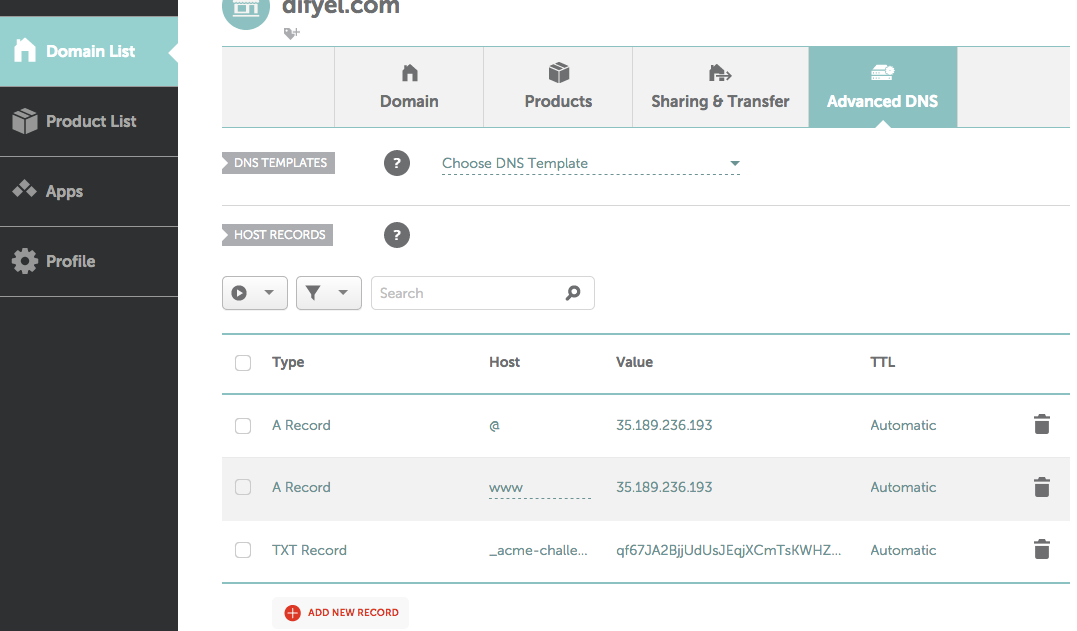
Select add new record , for type select text ,
for host select _acme-challenge.dev-freebsd if you
have a subdomain you are configuring like
dev-freebsd.difyel.com ,
or _acme-challenge if this is
your root domain like difyel.com .
You can check if the record has been updated by name cheap using the command :
#replace .dev-freebsd.difyel.com with your server name [root]$ host -t txt _acme-challenge.dev-freebsd.difyel.com Host _acme-challenge.dev-freebsd.difyel.com not found: 3(NXDOMAIN) # In this case , the record has not been updated . [root]$ host -t txt _acme-challenge.dev-freebsd.difyel.com _acme-challenge.dev-freebsd.difyel.com descriptive text "qf67JA2BjjUdUsJEqjXCmTsKWHZ_KR4HZRTiNTBU33o" # In this case , the record has been updated .
Once the record has been updated , press enter to continue verification .
Waiting for verification... Cleaning up challenges Subscribe to the EFF mailing list (email: uremail@address.com). IMPORTANT NOTES: - Congratulations! Your certificate and chain have been saved at: /usr/local/etc/letsencrypt/live/dev-freebsd.difyel.com/fullchain.pem Your key file has been saved at: /usr/local/etc/letsencrypt/live/dev-freebsd.difyel.com/privkey.pem Your cert will expire on 2021-01-14. To obtain a new or tweaked version of this certificate in the future, simply run certbot again. To non-interactively renew *all* of your certificates, run "certbot renew" - Your account credentials have been saved in your Certbot configuration directory at /usr/local/etc/letsencrypt. You should make a secure backup of this folder now. This configuration directory will also contain certificates and private keys obtained by Certbot so making regular backups of this folder is ideal. - If you like Certbot, please consider supporting our work by: Donating to ISRG / Let's Encrypt: https://letsencrypt.org/donate Donating to EFF: https://eff.org/donate-le
Now you must add the ssl configuration for your local domain ,
so replace your website configuration
/usr/local/etc/nginx/servers.conf.d/dev-freebsd.difyel.com.conf
with the following :
[root]$ nano /usr/local/etc/nginx/servers.conf.d/dev-freebsd.difyel.com.conf
# edit your website configuration , replace
# dev-freebsd.difyel.com.conf with your conf
# file name . and past the following code
server {
listen [::]:443 ssl http2 ; # Certbot
listen 443 ssl http2 ; # Certbot
ssl_certificate /usr/local/etc/letsencrypt/live/dev-freebsd.difyel.com/fullchain.pem; # Certbot
ssl_certificate_key /usr/local/etc/letsencrypt/live/dev-freebsd.difyel.com/privkey.pem; # Certbot
server_name dev-freebsd.difyel.com;
root /usr/local/www/nginx/;
client_max_body_size 512M;
# blog
location /blog {
expires $expires;
index index.php index.html index.htm;
try_files $uri $uri/ /blog/index.php?$args;
}
location ~* ^/blog/.*.php$ {
include fastcgi_params;
fastcgi_pass unix:/var/run/php-74-fpm.sock;
fastcgi_param SCRIPT_FILENAME $document_root$fastcgi_script_name;
}
# blog
}
server {
listen 80;
listen [::]:80;
server_name dev-freebsd.difyel.com;
return 301 https://$host$request_uri;
}
Test the configuration and restart nginx :
[root]$ nginx -t [root]$ service nginx restart
If you are not running your website locally , so like on a vps and can be accessed from the outside world , you can issue the following command in order to install ssl certificate .
[root]$ sudo certbot certonly --webroot -d difyel.com www.difyel.com # generate and install certificate for difyel.com and # www.difyel.com [root]$ echo "0 0,12 * * * root python -c 'import random; import time; time.sleep(random.random() * 3600)' && certbot renew -q" | sudo tee -a /etc/crontab > /dev/null # automatically renew the certificates
For local website you must renew your certificates manually .
To install mariadb , issue the following command :
[root]$ pkg install mariadb105-server # Install mariadb server , you can # install other versions by replacing # 105 by the version number , for example # 104 or 103
Configuration files for mariadb are
found under /usr/local/etc/mysql/ .
After installation , make mariadb starts when freeBSD stars , by issuing the command :
[root]$ sysrc mysql_enable="YES" # make mariadb starts when # freeBSD starts .
Start the mariadb server :
[root]$ service mysql-server start
You can stop the mariadb server by running
service mysql-server stop .
Secure mariadb by running :
[root]$ mysql_secure_installation
You can choose a password for the root user , or you can use socket authentication , you can remove anonymous account , disallow root from logging remotely , remove the test database , and reload the privileges tables .
[root]$ mysql_secure_installation
NOTE: RUNNING ALL PARTS OF THIS SCRIPT IS RECOMMENDED FOR ALL MariaDB
SERVERS IN PRODUCTION USE! PLEASE READ EACH STEP CAREFULLY!
In order to log into MariaDB to secure it, we ll need the current
password for the root user. If you ve just installed MariaDB, and
haven t set the root password yet, you should just press enter here.
Enter current password for root (enter for none):
OK, successfully used password, moving on...
Setting the root password or using the unix_socket ensures that nobody
can log into the MariaDB root user without the proper authorisation.
You already have your root account protected, so you can safely answer 'n'.
Switch to unix_socket authentication [Y/n] n
... skipping.
You already have your root account protected, so you can safely answer 'n'.
Change the root password? [Y/n] n
... skipping.
By default, a MariaDB installation has an anonymous user, allowing anyone
to log into MariaDB without having to have a user account created for
them. This is intended only for testing, and to make the installation
go a bit smoother. You should remove them before moving into a
production environment.
Remove anonymous users? [Y/n] y
... Success!
Normally, root should only be allowed to connect from 'localhost'. This
ensures that someone cannot guess at the root password from the network.
Disallow root login remotely? [Y/n] y
... Success!
By default, MariaDB comes with a database named 'test' that anyone can
access. This is also intended only for testing, and should be removed
before moving into a production environment.
Remove test database and access to it? [Y/n] y
- Dropping test database...
... Success!
- Removing privileges on test database...
... Success!
Reloading the privilege tables will ensure that all changes made so far
will take effect immediately.
Reload privilege tables now? [Y/n] y
... Success!
Cleaning up...
All done! If you've completed all of the above steps, your MariaDB
installation should now be secure.
Thanks for using MariaDB!
Restart mariadb server using :
[root]$ service mysql-server restart
To install postgresql issue the command :
[root]$ pkg install postgresql12-server # You can install other versions of postgresql # by changing the version number for example # 11 or 13
Make Postgresql start , when freebsd start by issuing :
[root]$ sysrc postgresql_enable="YES"
Initialize the database by running :
[root]$ service postgresql initdb
Start postgresql by running :
[root]$ service postgresql start # start the postgresql server .
You can stop the postgresql server by
running service postgresql stop
To install mongodb issue the following command :
[root]$ pkg install mongodb44 # Install mongoldb version 4.4 , # You can install other versions # like 42 36 ..
Make monogdb starts when freeBSD starts by issuing the following command :
[root]$ sysrc mongod_enable="YES"
You can start and stop mongodb by using the service command . Start mongodb by issuing :
[root]$ service mongod start
To install adminer issue the commands :
[root:/usr/local/www/nginx/]$ pkg install adminer # install adminer [root:/usr/local/www/nginx/]$ ln -s /usr/local/www/adminer/index.php /usr/local/www/nginx/adminer.php # create a symbolic link for # adminer inside nginx where # we are serving our website .
Set up basic authentication on nginx , start by generating a username and a password to protect adminer.php :
[root:/usr/local/etc/nginx/]$ echo "username:`openssl passwd -apr1 password`" >> .htpasswd # replace username by your username , and password with # your password .
Edit nginx.conf and define a rate limiting zone , to protect from brute force attack :
[root:/usr/local/etc/nginx/]$ nano nginx.conf # edit nginx.conf and add limit_req_zone $binary_remote_addr zone=shared:brute_force_protect:10m rate=1r/s; # Create a zone named : brute_force_protect # which will limit remote ip addresses # to only one http request per second .
Your nginx.conf should look like this as such :
worker_processes auto;
events {
worker_connections 1024;
}
http {
server_tokens off;
sendfile on;
tcp_nopush on;
tcp_nodelay on;
include mime.types;
default_type application/octet-stream;
gzip on;
gzip_proxied any;
gzip_vary on;
gzip_http_version 1.1;
gzip_comp_level 6;
gzip_min_length 96;
gzip_types text/plain;
gzip_types text/css;
gzip_types text/xml;
gzip_types application/javascript;
gzip_types application/json;
gzip_types font/woff;
gzip_types font/woff2;
gzip_types font/opentype;
gzip_types image/svg+xml;
gzip_types image/x-icon;
ssl_protocols TLSv1 TLSv1.1 TLSv1.2; # Dropping SSLv3, ref: POODLE
ssl_prefer_server_ciphers on;
ssl_session_cache shared:nginx_SSL:1m;
ssl_session_timeout 1440m;
ssl_ciphers "ECDHE-ECDSA-CHACHA20-POLY1305:ECDHE-RSA-CHACHA20-POLY1305:ECDHE-ECDSA-AES128-GCM-SHA256:ECDHE-RSA-AES128-GCM-SHA256:ECDHE-ECDSA-AES256-GCM-SHA384:ECDHE-RSA-AES256-GCM-SHA384:DHE-RSA-AES128-GCM-SHA256:DHE-RSA-AES256-GCM-SHA384:ECDHE-ECDSA-AES128-SHA256:ECDHE-RSA-AES128-SHA256:ECDHE-ECDSA-AES128-SHA:ECDHE-RSA-AES256-SHA384:ECDHE-RSA-AES128-SHA:ECDHE-ECDSA-AES256-SHA384:ECDHE-ECDSA-AES256-SHA:ECDHE-RSA-AES256-SHA:DHE-RSA-AES128-SHA256:DHE-RSA-AES128-SHA:DHE-RSA-AES256-SHA256:DHE-RSA-AES256-SHA:ECDHE-ECDSA-DES-CBC3-SHA:ECDHE-RSA-DES-CBC3-SHA:EDH-RSA-DES-CBC3-SHA:AES128-GCM-SHA256:AES256-GCM-SHA384:AES128-SHA256:AES256-SHA256:AES128-SHA:AES256-SHA:DES-CBC3-SHA:!DSS";
map $sent_http_content_type $expires {
default off;
application/atom+xml max;
application/javascript max;
application/rss+xml max;
application/vnd.ms-fontobject max;
audio/ogg max;
font/woff max;
font/woff2 max;
font/opentype max;
image/gif max;
image/jpeg max;
image/png max;
image/svg+xml max;
image/x-icon max;
text/css max;
text/html epoch;
video/mp4 max;
}
limit_req_zone $binary_remote_addr zone=brute_force_protect:10m rate=1r/s;
include servers.conf.d/*.conf;
}
Edit your website configuration file , in my case it is dev-freebsd.difyel.com.conf , and add :
[root:/usr/local/etc/nginx/servers.conf.d/]$ nano dev-freebsd.difyel.com.conf
#adminer
location =/adminer.php{
limit_req zone=brute_force_protect burst=20 nodelay;
auth_basic "Adminer Admin Area";
auth_basic_user_file .htpasswd;
include fastcgi_params;
fastcgi_pass unix:/var/run/php-74-fpm.sock;
fastcgi_param SCRIPT_FILENAME $document_root$fastcgi_script_name;
}
#adminer
So your website configuration file will look like this :
server {
listen [::]:443 ssl http2 ; # Certbot
listen 443 ssl http2 ; # Certbot
ssl_certificate /usr/local/etc/letsencrypt/live/dev-freebsd.difyel.com/fullchain.pem; # Certbot
ssl_certificate_key /usr/local/etc/letsencrypt/live/dev-freebsd.difyel.com/privkey.pem; # Certbot
server_name dev-freebsd.difyel.com;
root /usr/local/www/nginx/;
client_max_body_size 512M;
# blog
location /blog {
expires $expires;
index index.php index.html index.htm;
try_files $uri $uri/ /blog/index.php?$args;
}
location ~* ^/blog/.*.php$ {
include fastcgi_params;
fastcgi_pass unix:/var/run/php-74-fpm.sock;
fastcgi_param SCRIPT_FILENAME $document_root$fastcgi_script_name;
}
# blog
#adminer
location =/adminer.php{
limit_req zone=brute_force_protect burst=20 nodelay;
auth_basic "Adminer Admin Area";
auth_basic_user_file .htpasswd;
include fastcgi_params;
fastcgi_pass unix:/var/run/php-74-fpm.sock;
fastcgi_param SCRIPT_FILENAME $document_root$fastcgi_script_name;
}
#adminer
}
server {
listen 80;
listen [::]:80;
server_name dev-freebsd.difyel.com;
return 301 https://$host$request_uri;
}
Test nginx configuration files using nginx -t and
restart nginx using service nginx restart
Now when you try to access adminer you will be asked for a username and a password .
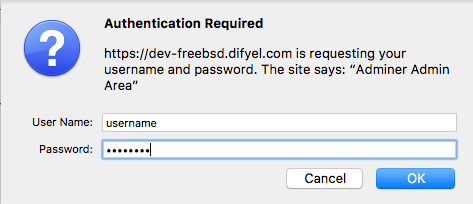
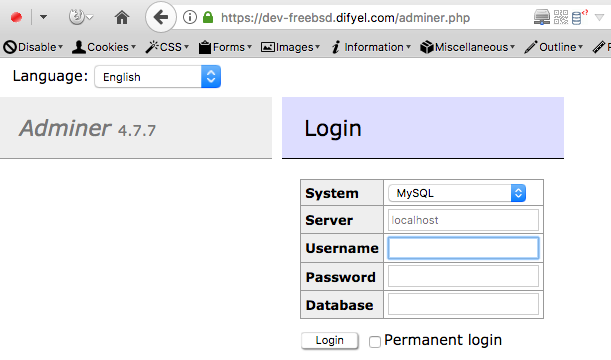
To be able to
connect to mariadb using adminer , create the user adminer and grant all privileges .
[root]$ mysql --user=root # connect to mysql CREATE USER 'adminer'@'localhost' IDENTIFIED BY 'password'; # replace adminer and password , by your username and password . GRANT ALL PRIVILEGES ON *.* TO 'adminer'@'localhost' WITH GRANT OPTION; # replace adminer with your username FLUSH PRIVILEGES;
Now you can use adminer to connect to mysql :

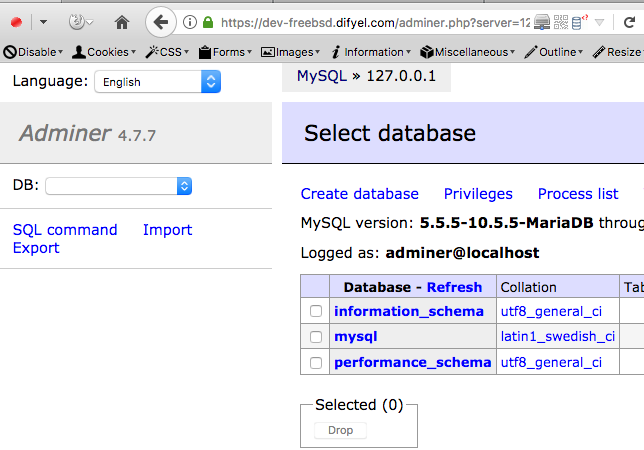
To
be able to connect to postgresql using adminer , create the user adminer .
[root]$ su - postgres $ createuser --interactive --pwprompt Enter name of role to add: adminer Enter password for new role: Enter it again: Shall the new role be a superuser? (y/n) y
Now you can use adminer to connect to postgresql :
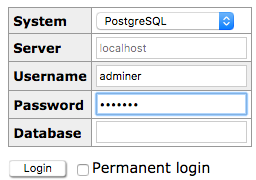
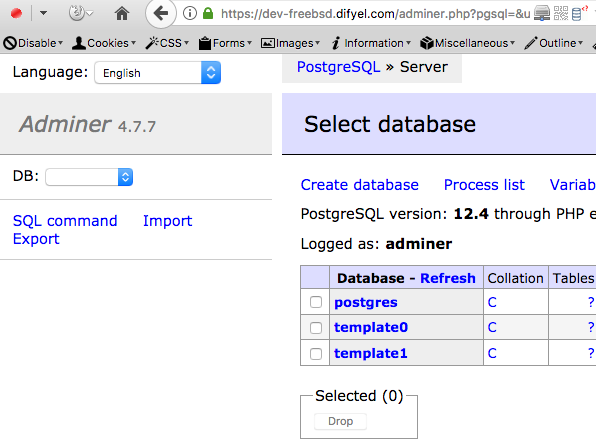
Download
Wordpress to the blog
directory on your website :
[root:/usr/local/www/nginx/blog/]$ wget https://wordpress.org/latest.tar.gz # Download the latest version of # wordpress using wget . # If you don't have wget installed , # you can install it using # pkg install wget
Extract and move the extracted files to blog :
[root:/usr/local/www/nginx/blog/]$ tar -xzf latest.tar.gz # extract Wordpress [root:/usr/local/www/nginx/blog/]$ mv wordpress/* . # move the content of the wordpress # folder to blog [root:/usr/local/www/nginx/blog/]$ # rm -r wordpress/ # remove the Wordpress directory [root:/usr/local/www/nginx/blog/]$ # rm latest.tar.gz # remove the latest.tar.gz file .
Create a database using adminer , go to
your http://your.web.site/adminer.php ,
and make a connection to mysql , next choose create database ,
select a name for your database and a collation ,
it is recommended to set the collation
to utf8mb4_general_ci if you don't find you language .
Then click save .

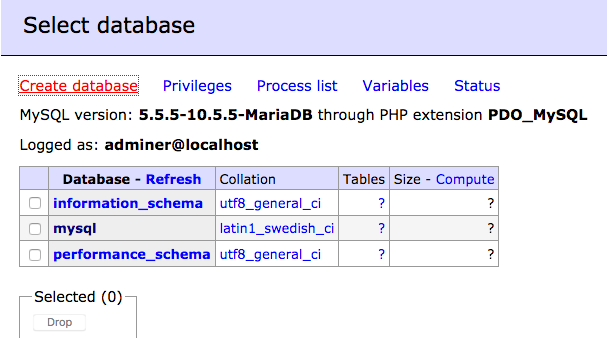

On the next page click on privileges , and then click on create user , and choose a username and a password , and tick the all privileges box , then click on save .
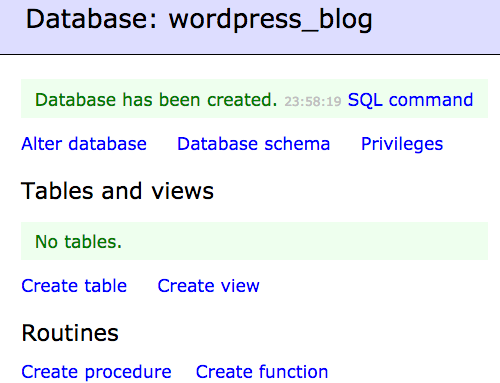
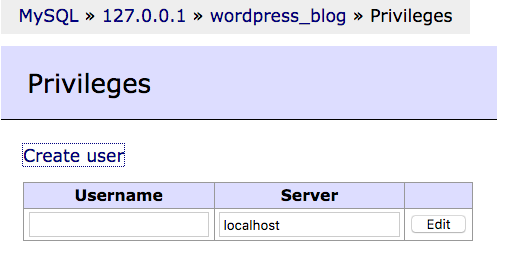

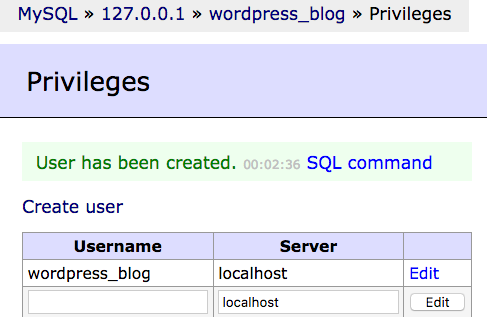
Next copy wp-config-sample.php into wp-config.php :
[root:/usr/local/www/nginx/blog/]$ cp wp-config-sample.php wp-config.php
And edit it to set up the database name ,
username and password as set earlier on ,
and to enable FS_METHOD direct ,
to enable the download of plugins ,
themes and updates without having an ftp server .
[root:/usr/local/www/nginx/blog/]$ nano wp-config.php define( 'DB_NAME', 'wordpress_blog' ); define( 'DB_USER', 'wordpress_blog' ); define( 'DB_PASSWORD', 'password' ); define( 'DB_HOST', '127.0.0.1' ); define( 'FS_METHOD', 'direct' ); # save and exit
Change the ownership of wp-content/ to www :
[root:/usr/local/www/nginx/blog/]$ chown -R www wp-content/ # Change the ownership of wp-content to # www
Visit http://your.web.site/blog/wp-admin/install.php to finish installing Wordpress .
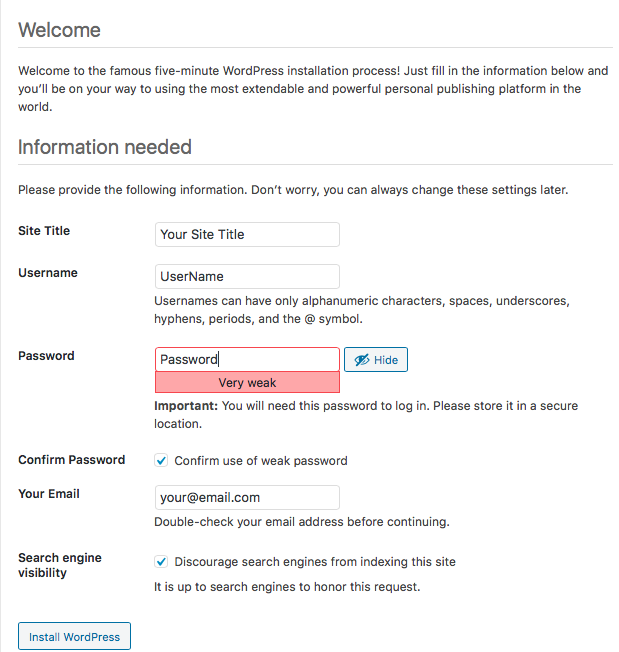
To install java , issue the following commands :
[root]$ pkg install openjdk11 # install jdk under Freebsd # You can choose to install another # version by substituting 11 , # for the version number you want # to install . For example # openjdk8 , or openjdk13 . root$ mount -t fdescfs fdesc /dev/fd # mount fdesc on /dev/fd root$ mount -t procfs proc /proc # mount proc on /proc root$ echo 'fdesc /dev/fd fdescfs rw 0 0' >> /etc/fstab root$ echo 'proc /proc procfs rw 0 0' >> /etc/fstab # auto mount fdesc and proc on boot
[root$] pkg install tomcat9 # Install tomcat under FreeBSD # you can substitute 9 , for the version # of tomcat you want to install , # for example tomcat8 .
Tomcat will be installed to /usr/local/apache-tomcat-9.0/ .
Make tomcat starts when freebsd starts by issuing the following command :
[root]$ sysrc tomcat9_enable="YES"
Edit your website configuration file , in my case it is dev-freebsd.difyel.com.conf , and add :
[root:/usr/local/etc/nginx/servers.conf.d/]$ nano dev-freebsd.difyel.com.conf
# Edit website configuration , and add two locations ,
# for tomcat manager and host manager applications .
#tomcat webapps
location /manager {
limit_req zone=brute_force_protect burst=20 nodelay;
expires $expires;
proxy_set_header Host $host;
proxy_set_header X-Real-IP $remote_addr;
proxy_set_header X-Forwarded-For $proxy_add_x_forwarded_for;
proxy_set_header X-Forwarded-Proto $scheme;
proxy_pass http://127.0.0.1:8080/manager;
}
location /host-manager {
limit_req zone=brute_force_protect burst=20 nodelay;
expires $expires;
proxy_set_header Host $host;
proxy_set_header X-Real-IP $remote_addr;
proxy_set_header X-Forwarded-For $proxy_add_x_forwarded_for;
proxy_set_header X-Forwarded-Proto $scheme;
proxy_pass http://127.0.0.1:8080/host-manager;
}
#tomcat webapps
Your website configuration file will look like this :
root:/usr/local/etc/nginx/servers.conf.d/]$ cat nano dev-freebsd.difyel.com.conf
# cat the content of dev-freebsd.difyel.com.conf
server {
listen [::]:443 ssl http2 ; # Certbot
listen 443 ssl http2 ; # Certbot
ssl_certificate /usr/local/etc/letsencrypt/live/dev-freebsd.difyel.com/fullchain.pem; # Certbot
ssl_certificate_key /usr/local/etc/letsencrypt/live/dev-freebsd.difyel.com/privkey.pem; # Certbot
server_name dev-freebsd.difyel.com;
root /usr/local/www/nginx/;
client_max_body_size 512M;
# blog
location /blog {
expires $expires;
index index.php index.html index.htm;
try_files $uri $uri/ /blog/index.php?$args;
}
location ~* ^/blog/.*.php$ {
include fastcgi_params;
fastcgi_pass unix:/var/run/php-74-fpm.sock;
fastcgi_param SCRIPT_FILENAME $document_root$fastcgi_script_name;
}
# blog
#adminer
location =/adminer.php{
limit_req zone=brute_force_protect burst=20 nodelay;
auth_basic "Adminer Admin Area";
auth_basic_user_file .htpasswd;
include fastcgi_params;
fastcgi_pass unix:/var/run/php-74-fpm.sock;
fastcgi_param SCRIPT_FILENAME $document_root$fastcgi_script_name;
}
#adminer
#tomcat webapps
location /manager {
limit_req zone=brute_force_protect burst=20 nodelay;
expires $expires;
proxy_set_header Host $host;
proxy_set_header X-Real-IP $remote_addr;
proxy_set_header X-Forwarded-For $proxy_add_x_forwarded_for;
proxy_set_header X-Forwarded-Proto $scheme;
proxy_pass http://127.0.0.1:8080/manager;
}
location /host-manager {
limit_req zone=brute_force_protect burst=20 nodelay;
expires $expires;
proxy_set_header Host $host;
proxy_set_header X-Real-IP $remote_addr;
proxy_set_header X-Forwarded-For $proxy_add_x_forwarded_for;
proxy_set_header X-Forwarded-Proto $scheme;
proxy_pass http://127.0.0.1:8080/host-manager;
}
#tomcat webapps
}
server {
listen 80;
listen [::]:80;
server_name dev-freebsd.difyel.com;
return 301 https://$host$request_uri;
}
For each tomcat web app you would like to access using nginx , you must add a location block .
Test the nginx configuration , and restart nginx .
[root]$ nginx -t [root]$ service nginx restart
Edit the tomcat-users.xml file , and add the line <user username ... , to enable access to the manager and host manager apps .
[root:/usr/local/apache-tomcat-9.0/conf/]$ nano tomcat-users.xml
<?xml version="1.0" encoding="UTF-8"?>
<tomcat-users xmlns="http://tomcat.apache.org/xml"
xmlns:xsi="http://www.w3.org/2001/XMLSchema-instance"
xsi:schemaLocation="http://tomcat.apache.org/xml tomcat-users.xsd"
version="1.0">
<user username="admin" password="password" roles="manager-gui , admin-gui"/>
</tomcat-users>
Replace username with your username , and password with your password.
Edit both context.xml in
the manager and host-manager web apps
and comment out the valve part to enable remote access
to the manager and host manager apps .
[root:/usr/local/apache-tomcat-9.0/webapps/manager/META-INF/]$ nano context.xml
# edit manager context.xml
<?xml version="1.0" encoding="UTF-8"?>
<Context antiResourceLocking="false" privileged="true" >
<!-- <Valve className="org.apache.catalina.valves.RemoteAddrValve"
allow="127\.\d+\.\d+\.\d+|::1|0:0:0:0:0:0:0:1" />-->
<Manager sessionAttributeValueClassNameFilter="java\.lang\.(?:Boolean|Integer|Long|Number|String)|org\.apache\.catalina\.filters\.CsrfPreventionFilter\$LruCache(?:\$1)?|java\.util\.(?:Linked)?HashMap"/>
</Context>
[root:/usr/local/apache-tomcat-9.0/webapps/host-manager/META-INF/]$ nano context.xml
# edit host-manager context.xml
<?xml version="1.0" encoding="UTF-8"?>
<Context antiResourceLocking="false" privileged="true" >
<!-- <Valve className="org.apache.catalina.valves.RemoteAddrValve"
allow="127\.\d+\.\d+\.\d+|::1|0:0:0:0:0:0:0:1" /> -->
<Manager sessionAttributeValueClassNameFilter="java\.lang\.(?:Boolean|Integer|Long|Number|String)|org\.apache\.catalina\.filters\.CsrfPreventionFilter\$LruCache(?:\$1)?|java\.util\.(?:Linked)?HashMap"/>
</Context>
Edit tomcat server.xmlfile and add a remote ip valve under host localhost , to enable correct passing of remote IP address and host information .
# Add a remote ip valve under
# <Host name="localhost" appBase="webapps" unpackWARs="true" autoDeploy="true">
<Valve
className="org.apache.catalina.valves.RemoteIpValve"
internalProxies="127\.0\.0\.1"
remoteIpHeader="x-forwarded-for"
protocolHeader="x-forwarded-proto"
requestAttributesEnabled="true"
/>
So your server.xml file will look like this :
<?xml version="1.0" encoding="UTF-8"?>
<Server port="8005" shutdown="SHUTDOWN">
<Listener className="org.apache.catalina.startup.VersionLoggerListener" />
<Listener className="org.apache.catalina.core.AprLifecycleListener" SSLEngine="on" />
<Listener className="org.apache.catalina.core.JreMemoryLeakPreventionListener" />
<Listener className="org.apache.catalina.mbeans.GlobalResourcesLifecycleListener" />
<Listener className="org.apache.catalina.core.ThreadLocalLeakPreventionListener" />
<GlobalNamingResources>
<Resource name="UserDatabase" auth="Container"
type="org.apache.catalina.UserDatabase"
description="User database that can be updated and saved"
factory="org.apache.catalina.users.MemoryUserDatabaseFactory"
pathname="conf/tomcat-users.xml" />
</GlobalNamingResources>
<Service name="Catalina">
<Connector port="8080" protocol="HTTP/1.1"
connectionTimeout="20000"
redirectPort="8443" />
<Engine name="Catalina" defaultHost="localhost">
<Realm className="org.apache.catalina.realm.LockOutRealm">
<Realm className="org.apache.catalina.realm.UserDatabaseRealm"
resourceName="UserDatabase"/>
</Realm>
<Host name="localhost" appBase="webapps"
unpackWARs="true" autoDeploy="true">
<Valve
className="org.apache.catalina.valves.RemoteIpValve"
internalProxies="127\.0\.0\.1"
remoteIpHeader="x-forwarded-for"
protocolHeader="x-forwarded-proto"
requestAttributesEnabled="true"
/>
<Valve className="org.apache.catalina.valves.AccessLogValve" directory="logs"
prefix="localhost_access_log" suffix=".txt"
pattern="%h %l %u %t "%r" %s %b" />
</Host>
</Engine>
</Service>
</Server>
You can start , stop , restart tomcat by using the service command . Start tomcat by issuing the command :
[root]$ service tomcat9 start
Go to your manager app , by visiting the address http://your.web.site/manager/

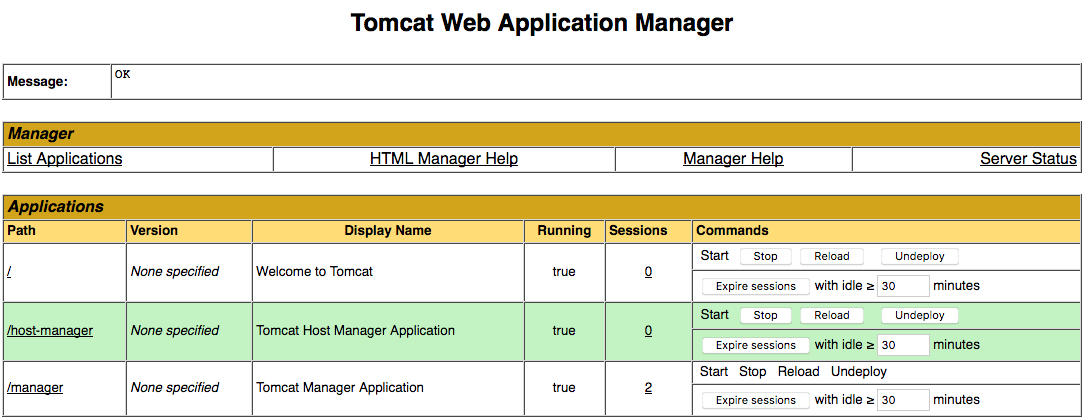
To install nodejs and npm issue the following commands :
[root]$ pkg instal node-14.13.0 npm-6.14.8 # You can substitute node version # number by another one .
To install Raneto wiki issue the following commands :
[root]$ npm install git # install git [root]$ npm install pm2 -g # install process manager # to start stop and daemonize # nodejs applications or other # applications or scripts . [root]$ adduser # create a user named node_pm2 # with home directory set to # /usr/local/www/node_apps/ Username: node_pm2 Full name: Uid (Leave empty for default): Login group [node_pm2]: Login group is node_pm2. Invite node_pm2 into other groups? []: Login class [default]: Shell (sh csh tcsh bash rbash git-shell nologin) [sh]: bash Home directory [/home/node_pm2]: /usr/local/www/node_apps/ Home directory permissions (Leave empty for default): Use password-based authentication? [yes]: Use an empty password? (yes/no) [no]: Use a random password? (yes/no) [no]: Enter password: Enter password again: Lock out the account after creation? [no]: Username : node_pm2 Password : ***** Full Name : Uid : 1002 Class : Groups : node_pm2 Home : /usr/local/www/node_apps/ Home Mode : Shell : /usr/local/bin/bash Locked : no OK? (yes/no): y adduser: INFO: Successfully added (node_pm2) to the user database. Add another user? (yes/no): n Goodbye! [root]$ su - node_pm2 # change to user node_pm2 [node_pm2:/usr/local/www/]$ git clone https://github.com/gilbitron/Raneto.git && cd Raneto # clone Raneto and cd into it [node_pm2:/usr/local/www/Raneto/]$ npm install && npm run gulp # install the Raneto application [node_pm2:/usr/local/www/Raneto/]$ nano example/config.default.js # search for base_url: '' , and # replace it with : # base_url: '/wiki' [node_pm2:/usr/local/www/Raneto/]$ pm2 start npm --name "Raneto" -- start # start the Raneto application using # pm2 , it will be restarted if it # crashes . [node_pm2:/usr/local/www/Raneto/] exit # switch back to the root account [root]$ bash # change to the bash shell . [root]$ env PATH=$PATH:/usr/local/bin pm2 startup rcd -u node_pm2 --hp /usr/local/www/node_apps/ # execute the following command to make # node_pm2 starts when freebsd starts , # and startup any application. [root]$ su - node_pm2 # change to user node_pm2 [node_pm2:/usr/local/www/]$ pm2 save # Save list of applications to # be started when freeBSD starts . [node_pm2:/usr/local/www/]$ exit # exit back to root
Edit nginx website configuration files , to proxy the wiki application just installed by adding the #wiki raneto block :
[root:/usr/local/etc/nginx/servers.conf.d]$ nano dev-freebsd.difyel.com.conf
# edit your website configuration
# file and add the raneto block
server {
listen [::]:443 ssl http2 ; # Certbot
listen 443 ssl http2 ; # Certbot
ssl_certificate /usr/local/etc/letsencrypt/live/dev-freebsd.difyel.com/fullchain.pem; # Certbot
ssl_certificate_key /usr/local/etc/letsencrypt/live/dev-freebsd.difyel.com/privkey.pem; # Certbot
server_name dev-freebsd.difyel.com;
root /usr/local/www/nginx/;
client_max_body_size 512M;
# blog
location /blog {
expires $expires;
index index.php index.html index.htm;
try_files $uri $uri/ /blog/index.php?$args;
}
location ~* ^/blog/.*.php$ {
include fastcgi_params;
fastcgi_pass unix:/var/run/php-74-fpm.sock;
fastcgi_param SCRIPT_FILENAME $document_root$fastcgi_script_name;
}
# blog
#adminer
location =/adminer.php{
limit_req zone=brute_force_protect burst=20 nodelay;
auth_basic "Adminer Admin Area";
auth_basic_user_file .htpasswd;
include fastcgi_params;
fastcgi_pass unix:/var/run/php-74-fpm.sock;
fastcgi_param SCRIPT_FILENAME $document_root$fastcgi_script_name;
}
#adminer
#tomcat webapps
location /manager {
limit_req zone=brute_force_protect burst=20 nodelay;
expires $expires;
proxy_set_header Host $host;
proxy_set_header X-Real-IP $remote_addr;
proxy_set_header X-Forwarded-For $proxy_add_x_forwarded_for;
proxy_set_header X-Forwarded-Proto $scheme;
proxy_pass http://127.0.0.1:8080/manager;
}
location /host-manager {
limit_req zone=brute_force_protect burst=20 nodelay;
expires $expires;
proxy_set_header Host $host;
proxy_set_header X-Real-IP $remote_addr;
proxy_set_header X-Forwarded-For $proxy_add_x_forwarded_for;
proxy_set_header X-Forwarded-Proto $scheme;
proxy_pass http://127.0.0.1:8080/host-manager;
}
#tomcat webapps
#wiki raneto
location /wiki {
expires $expires;
proxy_set_header Host $host;
proxy_set_header X-Real-IP $remote_addr;
proxy_set_header X-Forwarded-For $proxy_add_x_forwarded_for;
proxy_set_header X-Forwarded-Proto $scheme;
proxy_pass http://127.0.0.1:3000/wiki/;
}
#wiki raneto
}
server {
listen 80;
listen [::]:80;
server_name dev-freebsd.difyel.com;
return 301 https://$host$request_uri;
}
Test the configuration and restart nginx :
[root]$ nginx -t # Test the configuration [root]$ service nginx restart # Restart the nginx server .
Visit the wiki at the address your.website.com/wiki , and you will see the following page .

Can be added using the same method , by using nginx as reverse proxy .